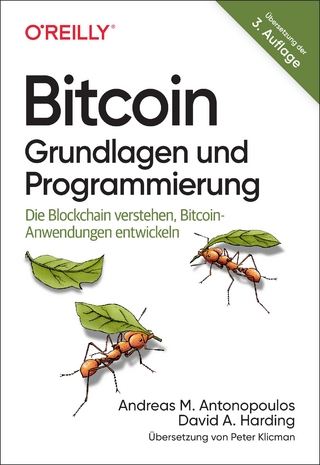
Cyberspace, Data Analytics, and Policing
Chapman & Hall/CRC (Verlag)
978-0-367-64776-6 (ISBN)
Key Features:
Provides a non-technical but robust overview of how cyberspace enables new kinds of crime and changes existing crimes.
Describes how criminals exploit the ability to communicate globally to learn, form groups, and acquire cybertools.
Describes how law enforcement can use the ability to collect data and apply analytics to better protect society and to discover and prosecute criminals.
Provides examples from open-source data of how hot spot and intelligence-led policing can benefit law enforcement.
Describes how law enforcement can exploit the ability to communicate globally to collaborate in dealing with trans-national crime.
David B. Skillicorn is a professor at the School of Computing, Queen's University, Canada.
Preface
List of Figures
List of Tables
Introduction
Cyberspace
2.1 What is cyberspace?
2.2 The impact of cyberspace
2.3 Identity and authentication
2.4 Encryption
2.5 Crime is changing
2.6 Policing is changing
New opportunities for criminality
3.1 Unprecedented access to information
3.2 Crimes directed against cyberspace
3.2.1 Malware
3.2.2 Crimes of destruction
3.2.3 Monetized cybercrimes
3.2.4 Data theft crimes
3.2.5 Secondary markets
3.3 Crimes that rely on cyberspace
3.3.1 Spam, scams, and cons
3.3.2 Financial crime
3.3.3 Online shopping
3.3.4 Crimes against children
3.4 Crimes done differently because of cyberspace
3.4.1 Disseminating hatred
3.4.2 Selling drugs
3.4.3 Stalking and crime preparation
3.4.4 Digital vigilantes
3.5 Money laundering
3.5.1 Cash
3.5.2 The financial system
3.5.3 International money laundering
3.5.4 Cryptocurrencies
3.6 Overlap with violent extremism
New ways for criminals to interact
4.1 Criminal collaboration
4.2 Planning together
4.3 Information sharing
4.3.1 Sharing techniques
4.3.2 Sharing resources
4.3.3 Sharing vulnerabilities
4.4 International interactions
Data analytics makes criminals easier to find
5.1 Understanding by deduction
5.2 Understanding by induction
5.3 Subverting data analytics
5.4 Intelligence-led policing
5.5 Hot spot policing
5.5.1 Place
5.5.2 Time
5.5.3 Weather
5.5.4 People involved
5.5.5 Social network position
5.6 Exploiting skewed distributions
Data collection
6.1 Ways to collect data
6.2 Types of data collected
6.2.1 Focused data
6.2.2 Large volume data
6.2.3 Incident data
6.2.4 Spatial data
6.2.5 Temporal data
6.2.6 Non-crime data
6.2.7 Data fusion
6.2.8 Protecting data collected by law enforcement
6.3 Issues around data collection
6.3.1 Suspicion
6.3.2 Wholesale data collection
6.3.3 Privacy
6.3.4 Racism and other -isms
6.3.5 Errors
6.3.6 Bias
6.3.7 Sabotaging data collection
6.3.8 Getting better data by sharing
Techniques for data analytics
7.1 Clustering
7.2 Prediction
7.3 Meta issues in prediction
7.3.1 Classification versus regression
7.3.2 Problems with the data
7.3.3 Why did the model make this prediction?
7.3.4 How good is this model?
7.3.5 Selecting attributes
7.3.6 Making predictions in stages
7.3.7 Bagging and boosting
7.3.8 Anomaly detection
7.3.9 Ranking
7.3.10 Should I make a prediction at all?
7.4 Prediction techniques
7.4.1 Counting techniques
7.4.2 Optimization techniques
7.4.3 Other ensembles
7.5 Social network analysis
7.6 Natural language analytics
7.7 Making data analytics available
7.8 Demonstrating compliance
Case studies
8.1 Predicting crime rates
8.2 Clustering RMS data
8.3 Geographical distribution patterns
8.4 Risk of gun violence
8.5 Copresence networks
8.6 Criminal networks with a purpose
8.7 Analyzing online posts
8.7.1 Detecting abusive language
8.7.2 Detecting intent
8.7.3 Deception
8.7.4 Detecting fraud in text
8.7.5 Detecting sellers in dark-web marketplaces
8.8 Behavior – detecting fraud from mouse movements
8.9 Understanding drug trafficking pathways
Law enforcement can use interaction too
9.1 Structured interaction through transnational organizations
9.2 Divisions within countries
9.3 Sharing of information about crimes
9.4 Sharing of data
9.5 Sharing models
9.6 International issues
Summary
Index
| Erscheinungsdatum | 05.10.2021 |
|---|---|
| Zusatzinfo | 5 Tables, black and white; 24 Line drawings, black and white; 24 Illustrations, black and white |
| Sprache | englisch |
| Maße | 152 x 229 mm |
| Gewicht | 540 g |
| Themenwelt | Literatur ► Biografien / Erfahrungsberichte |
| Mathematik / Informatik ► Informatik ► Datenbanken | |
| Informatik ► Netzwerke ► Sicherheit / Firewall | |
| Recht / Steuern ► Privatrecht / Bürgerliches Recht ► IT-Recht | |
| ISBN-10 | 0-367-64776-1 / 0367647761 |
| ISBN-13 | 978-0-367-64776-6 / 9780367647766 |
| Zustand | Neuware |
| Informationen gemäß Produktsicherheitsverordnung (GPSR) | |
| Haben Sie eine Frage zum Produkt? |
aus dem Bereich


